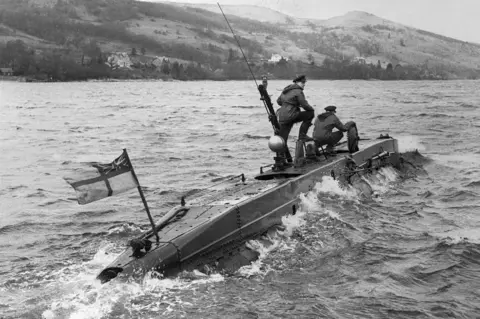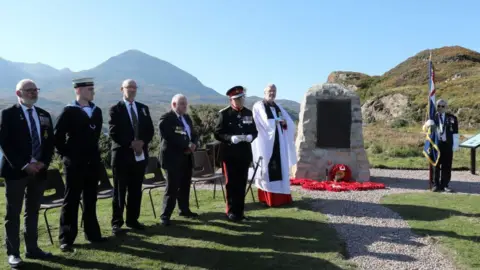Remembering WW2's lost X-Craft submariners
 Getty Images
Getty ImagesA memorial at a top secret World War Two training area in the Highlands has been given a revamp.
The cairn at Kylesku on Loch Cairnbawn, north of Ullapool, remembers 40 men of XII Submarine Flotilla who lost their lives either in training or while on frontline operations.
The submariners and divers were specialists in the use of mini, also known as midget, submarines called X-Craft and Chariots.
The memorial also recalls one of the flotilla's most dangerous operations, an attack on the German warship Tirpitz in a Norwegian fjord in September 1943.
 Peter Jolly/Northpix
Peter Jolly/NorthpixKylesku and the surrounding area was used for training between 1942 and 1945.
It was a restricted area and many of the operations the training was used for remained a secret until after the end of the war.
Loch Striven in Argyll and Bute was also used for X-Craft training.
The memorial cairn close to Kylesku Bridge, itself a landmark on the North Coast 500 tourist route, was installed in 1993.
But many of the names on its bronze plaque had become illegible due to exposure to bad weather over the last 30 years.
Over the last year, a small project team led by retired Royal Navy commander Tim Honnor raised £15,000 in donations to restore the memorial.
The cairn's mortar has been repointed and the worn bronze has been replaced by new cast made by the Nairn-based fine art foundry Black Isle Bronze.
New information boards made in Dumfries have been installed nearby, and the area tidied up by Reay Estate.
A ceremony to mark the completed refurbishment was held on Sunday.
Cdr Honnor said the site could become a focal point for people with links to XII Submarine Flotilla.
He said: "I hope that it will become a pilgrimage for relatives of those who are named on the roll of honour, and that it will bring their stories to a wider public."
 Getty Images
Getty ImagesIn 1943, the Tirpitz was the most heavily-armed warship in the world, said Cdr Honnor.
From Norway it attacked convoys of Allied shipping carrying weapons and supplies to Russia to help it fight Nazi forces on the war's eastern front.
Several attempts were made to sink Tirpitz.
From Kylesku six X-Craft were towed by larger submarines 1,000 miles to northern Norway.
Crew were onboard the X-Craft for the hazardous days-long passage.
Cdr Honnor said: "That must have been sheer hell.
"They were pitching all over the place, the air inside was disgusting and they could not have slept.
"They were being towed like a kite underwater."
Victoria Cross awarded
The crews were changed over for the attack, with three crewmen and a diver in each craft.
After losses along the way, only two X-Craft made it underneath Tirpitz to lay explosive charges.
The Royal Navy crews were forced to abandon their submarines and were captured by the Germans.
They were brought on board Tirpitz.
Cdr Honnor said: "There is a story about one of them who was asked why he kept looking at his watch.
"He knew when the charges would go."
Tirpitz was badly damaged by the explosives.
Cdr Honnor said an admiral, grudgingly impressed by their bravery, prevented the captured crew from being shot and ordered that they be held as prisoners of war.
Donald Cameron, from Carluke, South Lanarkshire, was among those later recognised for their bravery. He was awarded the Victoria Cross.
